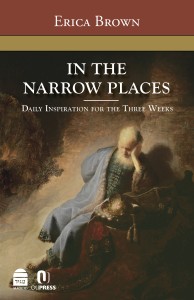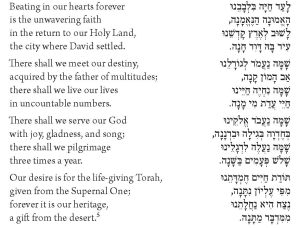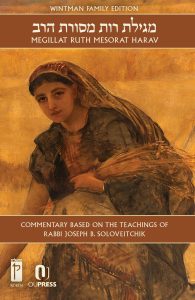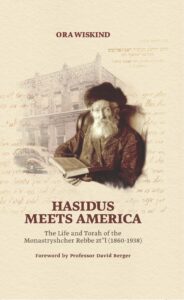Excerpted from In the Narrow Places: Daily Inspiration for the Three Weeks by Dr. Erica Brown, co-published by OU Press and Maggid Books
 Consolations
Consolations
According to Jewish law, there are four blessings that are made only once a year. One of them is made on Tisha B’Av and appears in the middle of the Amida prayer of the afternoon service. It is there that we acknowledge something unique about this fast day, above and beyond all others. Every day, three times daily, we pray for the rebuilding of Jerusalem and the ingathering of exiles. Every fast day, we insert special additional pleadings to intensify our supplications. But only on
this one day a year do we add a prayer for consolation.
At times of distress, we search for comfort, solace and empathy. When we feel low, we want companionship. We may not know – indeed, we rarely do – why this great anguish has come upon us. We cannot understand it. Consolation, when sincere, can help fill in the gaps of
incomprehension. When we have warmth, comfort and company, our failure to figure out life’s great mysteries somehow matters less. A tale is told among Hasidim about a young man who had suffered many great personal losses, and traveled far to see his rebbe, seeking clarity and renewed faith at a time that sorely tried him. He arrived at the rebbe’s court and blurted out his catalogue of misfortunes. The rebbe sat in silence and listened. Even when this disciple had finished, the rebbe sat in a prolonged and pregnant silence. The young man trembled. Finally, the rebbe got up and stood right next to his disciple and said in a hushed tone, “I cannot explain why any of these terrible things have befallen you. But I can stand beside you in anger.” That is consolation.
The special prayer of consolation we recite is a lengthy paragraph. Pay attention to its metaphors and the intricacies of its language:
Console, O Lord our God, the mourners of Zion and the mourners of Jerusalem, and the city that is in sorrow, laid waste, scorned and desolate; that grieves for the loss of its children, that is laid
waste of its dwellings, robbed of its glory, desolate without inhabitants. She sits with her head covered like a barren childless woman. Legions have devoured her; idolaters have taken possession of her; they have put Your people Israel to the sword and deliberately killed the devoted followers of the Most High. Therefore Zion weeps bitterly, and Jerusalem raises her voice. My heart, my heart grieves for those they killed; I am in anguish, I am in anguish for those they killed. For You, O Lord, consumed it with fire, and with fire You will rebuild it in the future, as is said, “And I Myself will be a wall of fire around it, says the Lord, and I will be its glory within” [Zechariah 2:9].Blessed are You, Lord, who consoles Zion and rebuilds Jerusalem.
This is a curious blessing. What kind of blessing offers a review of the tragic events that require consolation? Is it not odd that the prayer actually makes us feel worse before it makes us feel better? Jerusalem as a barren woman – as one who not only had children and lost them to exile, but as one who never had any children at all – bent over and disgraced, offers us the image of the woman alone in her suffering. She cries out, but no one is there to listen. Her insides bewail the losses all around her. Her enemies have triumphed and carried a nation away from its spiritual center. Is this review meant to offer us comfort or make us grieve harder?
The prayer is bookended with the image of God as consoler. God is introduced at the beginning of the blessing as the one who consoles mourners, as if He were going to the shiva house of the entire Jewish people. At its closing, God is described not as a comforter but as a protector, a fire-wall. This image comes from Zechariah 2:9, from a chapter of consolation spoken by the prophet who led the Israelites out of Babylon and back to Zion. Immediately preceding the verse chosen for our liturgy is a celebratory passage that stands in sharp contrast to Jerusalem as an abandoned city: “Jerusalem shall be peopled as a city without walls, so many shall be the people and cattle it contains” (Zechariah 2:8). The walls that contained the fires of devastation will be bursting with inhabitants. They will be knocked down to accommodate the flooding of people. The language is exhilarating:
“Shout for joy, Zion! For Lo, I come, and I will dwell in your midst,” declares the Lord. In that day, many nations will attach themselves to the Lord and become His people, and He will dwell in your midst. (Zechariah 2:14–15)
This is more than the consolation of comfort. It offers a picture of the future, and communicates hope and optimism. Zechariah’s image makes us want to join in the momentum of redemption. He extends the appeal of Zion far beyond the nation alone. Everyone will want to be there. God will be a magnet to newcomers and will dwell in Zion. God’s presence will be securely felt.
The contrast between our prayer and Zechariah’s hopefulness raises the question of how to define consolation. Consolation is not meant to be a distraction. It is not about looking elsewhere, in the future, to the side, somewhere other than despair. Zechariah’s visions are prophetic and futuristic. Consolation is about looking exceedingly closely at a past from which it is all too easy to turn away and deriving meaning and comfort from it. It is the confrontation of grief in company.
Think about a visit to a mourner, a house of shiva. Many mourners during the shiva period try to focus all conversation on the person lost. We are there to be together with the mourner as he looks back. The consolation is in the details, in the reflection and contemplation of a life and the often sad and heart-wrenching last months and days. One can only really get to the other side of tragedy by immersing oneself in it and then emerging. Doctors often recommend that mourners not take medications that numb anxiety or ease pain because it is well known that this failure to grieve intensely will only prolong an inability to move on.
Who truly provides consolation – those at a shiva who ignore the pain and speak of unrelated issues, or those who are not afraid to ask “When did your mother get sick?” “What did she have?” “How did you handle it?”? These questions do not minimize the pain; they invite the mourner into a dialogue about what really happened, into a human encounter more profound for its harsh honesty.
God consoles us in this prayer not by avoiding the pain but by mourning the loss with us. That is true empathy. We feel solace not when someone explains away the reason for our suffering or distracts us with images of a redeemed future, but when God stands beside us in our anger and disbelief.
Kavana for the Day
Who in your life needs consolation right now? Think of someone who, in the past year, lost a spouse, a parent, or a sibling. We know that the intensity of loss changes over time, but is never gone. Over the year, the mourner’s experience is softened and cushioned. Most mourners are comforted by their respective communities during the shiva period, the initial seven days. Yet many people feel that the hardest point is when they get up from the shiva – when no one is in the house and suddenly the aloneness of the situation seems unbearable. Since the process of consolation takes time, call or get together with someone who has suffered a recent loss and ask them how they’re doing. Don’t just make it a quick question, show concentrated interest: how has life changed for you? How often do you think of the person you lost? What has brought you solace in these months? Some mourners may choose to be more private, but others may wish to be asked. Some may feel that people only really “cared” during the week of shiva. Mourning takes time. Consolation requires patience and extended compassion.






